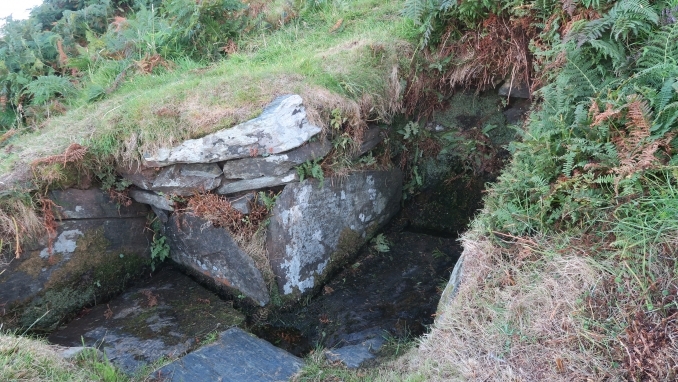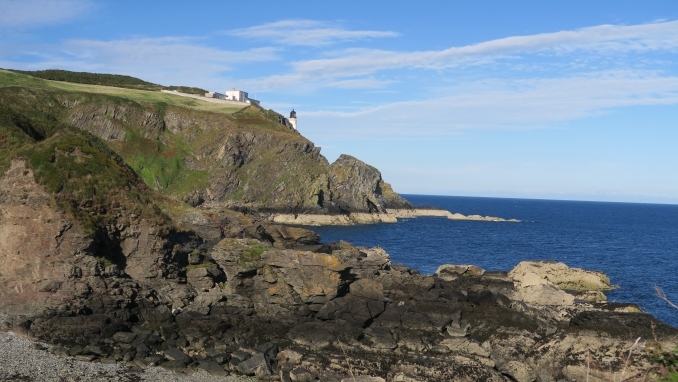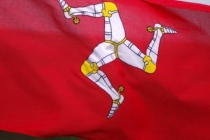Çhibbyr Maghal - St Maughold's Well

Christianity was brought to the Isle of Man (Manx: Mannin) by Irish missionaries. According to legend, Saint Patrick came to the Island first setting foot on a small island off the Isle of Man that still bears his name, St Patrick's Isle (Manx: Ellan Noo Perick). There are a number of early churches (Keeills) dedicated to Patrick (Manx: Pherick) and two parish churches. There are also a number of holy wells named after him. Although the patron saint of Ireland, Saint Patrick is very important in the Manx Christian tradition.
However, it is Saint Maughold (died ca. 498 AD) that is venerated as the patron saint of the Isle of Man/Mannin. Tradition has it that Saint Maughold, whose feast day is April 27th, was an Irish Prince, Macc Cuill. One legend is that he was leader of a band of thieves and converted to Christianity by Saint Patrick. In penance, he set sail from Ireland in a boat without oars and drifted to the Isle of Man/Mannin where he landed close to the headland that still bears his name: Maughold Head (Manx: Kione Maghal). Due to his piety and good behaviour towards the Manx people he was chosen as Bishop of Man.

Maughold Head (Kione Maghal) is a place of stunning beauty. It is the easternmost point on the island and has a lighthouse nestling next to the steep cliff. Walking along the coastal path from the small village of Port-e-Vullen takes you to the headland which rises majestically above the Irish Sea. A path on the north side of Maughold Head leads down to an ancient spring within a rocky crevice said to have been used by Saint Maughold and called Çhibbyr Maghal (St Maughold's Well). It is a slow running spring with a small bowl shaped hollow carved by centuries of dripping water. It is framed by stone slabs, including a space where you can sit. The well was principally said to have been visited by local people on Easter Day and the second Sunday in August. Offerings, including little crosses made of straw, were thrown into the water at the moment when the sun was seen to be rising out of the sea. The well was also said to have been " dressed," on every 12th of August. The water was taken as a cure and seen as providing protection. It remains a peaceful and very special place to visit.

The village of Maughold lies to the west of the headland. It was the site of a 5th century Celtic monastery. Maughold churchyard has within it the remains of three ancient Keeills. The present church dates from around the 11th to 12th century. A large number of Celtic Crosses and Norse carvings dating from the 6th to 13th centuries are housed in a collection within the churchyard. There was also once an ancient pre-historic tomb on the site. A journey to Maughold Head and St Maughold’s Well is complimented by visiting Maughold churchyard.
Manx poet and playwright, Josephine Kermode (1852–1937) who used the pen name 'Cushag', which is the national flower of the Isle of Man, wrote this poem about Maughold:

At Maughold
by Josephine Kermode (1852–1937)
The joyous company of mounting larks
Sing to the quiet dead,
And slumber song of thymy bees is heard
Around their bed;
While nought may vex them there on Maughold’s breast
Nor wake the summer stillness of their rest.
And on the hill their sleeping kinsfolk lie
Beneath the driving gale;
They heed not beat of sun nor whirling blast
Nor winter hail;
But rest as sweetly under storm and snow
As those who shelter with the Saint below.
Enough for One they reached their Home at last
By roads that could not meet,
Until the shining of the sunset light
Showed weary feet
That all those diverse paths that late they trod
Were byways only of the road to God.
Discover more places to visit in the Isle of Man with our hand curated Manx itineraries.
- Manx
- English
- Log in to post comments






